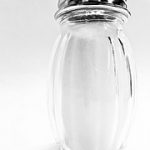Have you ever heard of the “5-Ingredient” rule? Some people say that if a food has more than five ingredients on the label, you shouldn’t buy it.
I think this is kinda dumb.
Do you ever use more than five ingredients in preparing foods you make at home? Sure. Does using more than five of them magically make your food bad for you? Obviously not.
The purpose behind the 5-ingredient rule is to avoid heavily processed foods, which is a good goal, really. But unless you plan on buying absolutely zero processed foods and literally making every single thing you eat from scratch, it’s really a much better idea to just figure out what ingredients you actually need to avoid, as opposed to just counting them.
And when I say “processed,” I’m talking about anything that comes in a package or has a label whatsoever — that’s by definition, processed. Even the highest-quality grass-fed beef is usually cut and processed into a package. The freshest, healthiest raw cream didn’t churn itself into butter.
What we really are trying to stay away from are all the packaged convenience foods loaded with chemical fillers, preservatives, additives, colorings, and artificial flavors, sweeteners, and other general fakeness. I can think of plenty of things that pass the 5-ingredient test that I know I shouldn’t be eating.
Just the other day, I came across a bag of totally unsuspicious looking tortilla chips with only three ingredients:
- Corn (which wasn’t organic and almost certainly genetically modified)
- Vegetable oil (from GM soy, packed with thyroid-suppressing, metabolically destructive, and inflammatory polyunsaturated fat)
- Salt (bleached, stripped and chemically-treated sodium chloride)
Well hey — looks like it passed the 5-ingredient test! Guess I’ll eat it!
Yeah, no thanks.
So, here’s what I think makes a whole lot more sense.
If you…
- Can’t pronounce it (“Trimegadi…whaaa?)
- Don’t know what it is (“Natural flavors, huh. From… what exactly?”)
- Can’t buy it in a store (“Oh, you’re looking for disodium guanylate? Aisle 3.”)
- Wouldn’t stock your cupboards with it (“Hey there, neighbor. I ran out of methylcellulose. Could you spare a tablespoon or two?”)
… you might want to reconsider eating it.
These “mystery ingredients,” as I like to call them, are what we really want to look out for. This is my rule: if you buy processed food, read the label. Know what you’re getting. And if it’s got a bunch of crap in it that you’re not okay with ingesting, try to find another choice that doesn’t.
Super-Important Disclaimer
Here’s the deal though — there is no reason, under any circumstances, to get all paranoid over this stuff!! The point is that we’re empowering ourselves by understanding what’s healthy and what’s not, as opposed to just blindly following the herd of genetically-modified sheep-eaters.
So, if your absolute FAVORITE food in the whole wide world has some sort of inconspicuous “natural flavors” or something on the ingredient list, that doesn’t mean I think you should absolutely never eat it.
I think it’s perfectly healthy to break the “rules.”
Just yesterday, in fact, I saw a little snack-pack-sized bag of those frosting-coated circus animal cookies in the cupboard at my in-laws’ house. You know, the pink and white ones with the little sprinkles?
I don’t know why, but for some reason those sprinkly little camels and rhinoceroses were calling my name.
I picked up the pack of cookies, completely and intentionally avoided even glancing at the ingredient list, and happily popped each one of them into my mouth.
I still haven’t looked at that label. But I’m positive it breaks every rule in the book. And does that really matter? To me, no. Because I do not believe in food restriction. Period. I only believe in food education. I know there’s most likely all sorts of stuff that isn’t good for me in those cookies. That’s probably why up until yesterday, I hadn’t eaten one in like five years. I generally wouldn’t pick up something like that at the store because of two reasons:
- I know what’s in it—and that isn’t something I want to be eating on a regular basis, and
- I can have it whenever I want, if I choose to, because no food is off limits to me.
And because of these reasons, the “bad” foods with many more than 5 ingredients on the label lose their appeal to me. So I wind up making good choices, enough of the time, to constitute a healthy diet. It’s perfectly fine if I choose to eat something outside of that scope if it sounds good to me.
Enough with the rules, already.
Are you more interested in making sure your diet is nutritious and healthy on the whole, rather than nit-picking every little morsel you eat and sticking it with a “good” or “bad” label? Me too.
That’s why I wrote Real Food for Real Life: How to Eat Healthy Without Going Completely Crazy. If you want to learn what’s really important when it comes to eating a healthy diet, rather than forcing yourself to obey a bunch of rules that don’t really make sense, I think you’ll probably like the book.
Right now, it’s available as part of the big Fall into Health Autumn Sale—with over $2,000 worth of products and resources for 98% off! BOTH of my ebooks are included, plus 45 more, plus tons of other amazing stuff!
But hurry! The big sale ends on November 7th at midnight.
How do you feel about food rules?
Leave your thoughts in the comments below.







I am pretty new to the “real food” world and it can definitely be overwhelming at times. But, I have to give you props…. your blog is the most realistic, down to earth, SANE approach that I have seen so far! When I find my head spinning from reading my fifth article about why this is bad, that is good, NEVER do this, ALWAYS do that, you come along with something like this that makes me realize it doesn’t have to be so complicated. Thank you!!
Wow, what amazing feedback! Thank you so much, Kerry!
I feel the same. Your posts are always so refreshing and don’t make me feel like a complete failure for not doing everything right everyday. I’m not even close to 80/20 yet, but I’m working on it. So thanks! I bought the bundle, and I’m looking forward to checking out your book.
I’m totally with you on not being paranoid and on not restricting foods. Yesterday, we decided to make an unplanned trip to a Pittsburgh museum which is a little over an hour away. Rather than eat at restaurants which can be pricey for a family of 4, we hit up the local grocery store which has mostly packaged convenience foods and no organic options. One the items I got for breakfast on the go was a box of poptarts. Before switching to real food, poptarts were a regular and most favorite “food” in our house. Knowing full well the list of nasties in the tarts, I happily enjoyed every last crumb of those brown sugar cinnamon bad boys. Today has been completely fake food free. LOL I think people who get all stressed out over every little thing they put in their mouths are less healthy than those who occasionally have a walk on the dark side of food. 🙂
I cannot stand pop tarts. Just thinking about them makes my stomach queasy, lol. However, my husband LOVES them. Recently I bought him some (we haven’t had them in our house for over a year). He gave me a big hug and asked what he did to deserve this special treatment, haha!!
How can I not have a treat like that for him every once in a while? I just close the door to my office and put some drops of essential oils around me to cover up the horrible smell of them in the toaster 🙂 But he is happy, and that makes me ok with it once in a while.
🙂
I agree 100%. We do clean eating and I’ve definitely adapted it. That 5 ingredient rule is too silly. Especially with things like your example above, just because it’s under 5 doesn’t mean it’s good for you. Thank you for your common sense blog!
This is awesome! The other day I saw tea that had “natural sugar cookie flavoring” in it. Ya, I know what a sugar cookie but I don’t know what it’s natural flavoring is…. hahaha. Thanks for the great myth buster and better explanation!
It’s official. This is my favorite blog to read. Thanks for simply calming all the confusion and just making sense. Kind of embarrassed to say this but, reading your blog has given me the courage & freedom to think for myself a little about my food choices! I admit, as a newbie to the real food world, I was getting caught up in the rules and the do’s & don’ts…
I cook everything we eat from scratch and definitely in a lot of cases use more than 5 ingredients. But my body CANNOT tolerate those Himalayan pink salts or Celtic sea salts, and I even have low blood pressure. They give me killer headaches where I think I’m going to have an aneurysm. What’s in those salts?
Can you use normal table salt from the store?
It could be that your body is detoxing (a headache is a big sign of a detox) but it sounds like you are a healthy eater as it is, and may not need to detox like that. The salts have trace minerals in them, but I have never heard of someone allergic to the trace minerals…. very interesting.
Have you had any bloodwork done?
One thing that gets me is chocolate. How unfair is that? Raw cacao, with coconut oil, raw honey/stevia, homemade vanilla and sea salt… that is super healthy but I cannot eat it because of the theobromine in chocolate. I don’t eat sugar so it has been so long that I had regular store bought chocolate so I don’t know if that affects me now as well.
Good luck!
I agree that the 5 ingredient rule is bogus, but I have an issue with the “can’t pronounce it” rule. Actually, this is a pet peeve of mine. A chemical name is what it is: A description of the molecule that makes up that substance. Truth is, everything has a chemical name. Some thing happen to have common names also, but that doesn’t mean they are less scary or healthier, it just means they have a common name. Calling something sodium chloride doesn’t make it more dangerous than calling it salt. If you were pregnant, would you carefully avoid any food containing pteroylglutamic acid? Well, you’d be in trouble if you did, because this is folic acid and essential for the healty development of your baby. When you eat asparagus, you are eating a ton of things that have chemical names, it’s just that collectively they are called asparagus. What you should do is look up the name of anything you aren’t familiar with and see what it is and what it does.
Oh, and disodium guanylate is a naturally-occuring salt that is obtained from dried fish or seaweed and used as a flavor enhancer.
Well, I have found a brand of corn tortilla chips I can live with. They are made with nextimalitized corn, fried in an oil mixture that includes palm oil, and salt. Shockingly, this is an off brand I’ve only found one place – at Save A Lot of all places.
For all your passion about real food and traditional preparation, you have one of the most sane, down to earth approaches of any food blogger I’ve yet read. Please keep blogging!
I think the phrasing of the five-ingredient rule is just to give people a jumping-off point. I know that if I flip over a package and see a huge wall of text, I immediately put it back – I’m not even going to bother. But overall, yeah, I agree. I go by the “if you wouldn’t cook with it in your own kitchen” rule.
Yep, dumb rule. Um, curry? is that bad? not even close! Geesh, even broth usually has more than 5…. same category as the “can’t pronounce it” rule. Doesn’t really even make sense, and way oversimplifies the point.
Haha, well, I did mention the “can’t pronounce it” thing in my suggestions, but I only really mean that in combination with the others. As in like, if you have no clue what it is and you couldn’t go out and get it yourself. I’m sure there’s things I’d have a hard time pronouncing that aren’t actually bad for you. But, I think you know what I mean. 😉
I DO know what you mean 😉 I still think it’s a bad rule. I think a better “rule” is ‘if you can’t go out and buy the ingredient’ but I still think it’s silly to make that rule. At some point you just have to use your brain, and not oversimplified “rules”.
Yep. That’s pretty much exactly what I was trying to say with this post.
Love this post!
My thought is that my food rules keep me healthy and de-stress all those moments when I’m figuring out what I’m going to buy for eating that week. And like any good set of rules, they are meant to be broken every once in awhile. Also, my food rules change, sometimes gradually and sometimes instantly as I learn new things externally and figure out what feels right (or wrong!) internally. I don’t judge the food rules of my past, just like I don’t judge the food rules of anyone else around me.
One of my food rules used to be “Fast food is for teenagers and road-trips.” Now that my son is soon to be a tween I don’t really like the teenager part anymore. But boy, did I eat a lot of fast food in my teenage years. 🙂
I agree. And not everything has to be homemade. I tried that for a little while and burnt myself out. I go ahead and buy an Amy’s pizza or another meal. It is delicious and I am comfortable with most of their products. So the saying “If it comes in a box you should avoid it” really doesn’t make since to me. Sure, 90% of what comes in a box is terrible. But we need our “fast food” too when we are busy or tired and these ones are made so much better than mainstream brands. I know my diet isn’t perfect and I am not a 100% real food grown right yet. I’d love to be there but finances and time stop me. My goal will be in 11 months to be completely transfered over lotion and cleaning products included. If I am never perfect, that’s ok too. Thanks for the great article!
This post really spoke to me. I’m all about being aware of what you take into your body. Sometimes, having a snack that’s full of crap chemical ingredients just sounds good. I think being aware that it’s loaded with rocks and petroleum is likely to make you crave it less often. But I think denying yourself that food entirely is more likely to lead to bingeing on it, and having not 1 powdered donut, but 6, because they’re SOOOOOO good right now.
Thanks for sharing this!
Like Kit said above, I think the 5-ingredient “rule” is meant as a starting off point to encourage people to be weary of packages that contain a whole lot of extra stuff that wouldn’t be needed if you just made the food from scratch.
I also think that the more ingredients that are listed (whether you can pronounce them or not), the more opportunity there is for manufacturers to add in little “extras” that they don’t even have to label. So even if a label has 5 ingredients listed, you could be getting even more.
Personally, I like to choose foods with as few ingredients as possible (the best case scenario is that it is a 1-ingredient whole food), and just cook/bake at home. I know not everyone is comfortable in the kitchen though. That’s why your main point is so important. It’s not necessarily the amount of ingredients that is important – it’s what those ingredients are. We should all just be more aware of what we are putting into our bodies, and make the choices that we are comfortable with.
Great post as always